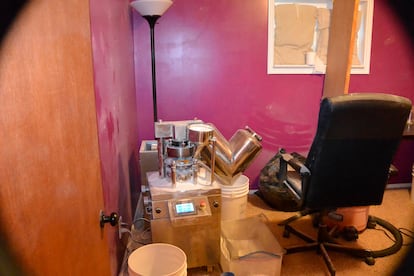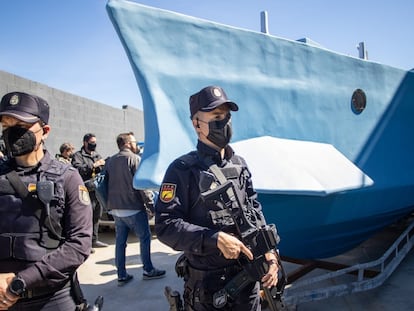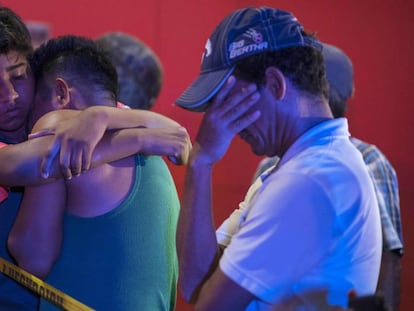Methamphetamine and online sales: How Mexican drug cartels are gaining ground in the US and Europe
A new report from the United Nations Office on Drugs and Crime warns that trafficking has also increased in Asia and Oceania, while seizures on the border have doubled


Mexican drug cartels have strengthened their presence in the United States and Europe, and consolidated business in Asia and Oceania thanks to the rise of methamphetamines. That’s according to the United Nations Office on Drugs and Crime (UNODC), which presented the report Synthetic Drugs and New Psychoactive Substances in Latin America and the Caribbean last week in Vienna. The document warns that there has been an increase in the trafficking of methamphetamine, a drug principally made in the Mexican states of Baja California, Sinaloa, Jalisco and Michoacán. Mexican drug traffickers, led today by the Jalisco New Generation Cartel (CJNG), have widened their channels of international distribution. Cocaine and cannabis continue to dominate the illegal market, but methamphetamine and the advent of fentanyl, a synthetic opioid, “have significantly changed the synthetic drug landscape” and the challenges it poses, says the report.
One such challenge is the rise of online drug sales, a trend that is linked to the travel restrictions introduced due to the coronavirus pandemic. “Traffickers may shift even more toward online drug-trafficking business models to expand their businesses and networks, and that this particular trafficking model may become a more prominent fixture in the illicit regional drug market after the pandemic,” the document warns.
Evidence shows that demand for methamphetamine already dominates the synthetic-drug market and is on the rise. “Large amounts of methamphetamine are trafficked from Mexico to the United States and an increasing amount of methamphetamine has been seized in both countries along this part of the border,” the report explains. “In 2018, methamphetamine seizures along this border were more than three times higher than in 2013, and the amounts seized in the financial year 2020 were double those of 2018.” Methamphetamine seizures in the US also doubled between 2017 and 2019, according to the document.
Although the number of illegal labs dismantled in Mexico has dropped, the UNODC says that this does not necessarily mean that methamphetamine production has fallen too. Indeed, according to the United States Drug Enforcement Administration (DEA), “the production capacity of individual laboratories in Mexico has recently increased, so that a smaller number of large-scale manufacturing facilities are required to produce large amounts of methamphetamine,” the report explains.
At the US-Mexico border, drug traffickers are using different techniques to avoid detection, such as dissolving methamphetamine in solvents to “traffic it in liquid form,” says the document. Once over the border, the drug is usually taken to “a conversion laboratory in the destination country, where the solution is converted back to crystalline methamphetamine.”
Mexican drug cartels are also continuing to increase their activities outside of the region. According to the report, Mexican drug traffickers have increased their distribution in Europe. In March 2020, just as the coronavirus pandemic hit Europe, Spanish authorities seized a shipment of more than 270 kilos of methamphetamine from Mexico. This is so far the largest methamphetamine operation ever to be carried out in Spain. Not long after that operation, Slovakia seized a shipment of 1.5 tons of methamphetamines.
Online trafficking and distribution of drugs via postal or courier services in the region are likely to have gained popularity during the pandemicUNODC report
The UNODC report indicates that “in both of these cases it remains unclear whether Europe was intended as the final destination for the seized methamphetamine or whether these shipments were destined for onward trafficking.” Several Mexican nationals have also been arrested for their involvement in the manufacture of methamphetamine in Europe, including four in the Netherlands in 2019. The drug is also being trafficked to several countries in Asia and Oceania. While some of these shipments are sent from the US, the UNODC document states that their size “suggests that criminal groups with access to large amounts of methamphetamine are involved” – in other words, Mexican drug cartels.
Japan, Australia and New Zealand are among the countries most affected in the Oceania region. According to the UNODC, there have been a number of cases of methamphetamine being trafficked “by plane, by ship and by mail.” The report links this last mode of trafficking to the coronavirus crisis, given restrictions on movement made street-level dealing more difficult. “Online trafficking and distribution of drugs via postal or courier services in the region are likely to have gained popularity during the pandemic,” it finds. The report also warns that “while there is increasing awareness of synthetic drugs among governments in the region, many still lack the functional capacity to systematically scrutinize their mail stream for such substances.”
The document does not discuss violence, which is the main consequence of drug trafficking. In recent years, the Mexican government has tried to change its approach to the fight against organized crime, which has cost the lives of tens of thousands of civilians. Mexican President Andrés Manuel López Obrador supports a policy of “hugs not bullets.” This program, which has come into question, seeks to help alleviate poverty and promote development in the areas affected by drug trafficking.
The Mexican government has also signed a new security agreement with the US administration of Joe Biden, which aims to find solutions to the structural causes of the problem, although there are few details about the pact. The plan, dubbed the United States-Mexico Bicentennial Framework for Security, Public Health and Safe Communities, intends to switch the focus to drug consumption, and its main goal is to support economic development in areas used for drug manufacture and those along the border. The previous plan, called the Mérida Initiative, was formed under the administration of former US president George Bush, and has since reached its end. Under this policy, the US has spent about $3 billion (€2.58 billion) since 2007 to assist Mexico in the fight against organized crime. It is not currently known what the budget will be for the new strategy, a detail that will need to be confirmed by the end of the year.
Tu suscripción se está usando en otro dispositivo
¿Quieres añadir otro usuario a tu suscripción?
Si continúas leyendo en este dispositivo, no se podrá leer en el otro.
FlechaTu suscripción se está usando en otro dispositivo y solo puedes acceder a EL PAÍS desde un dispositivo a la vez.
Si quieres compartir tu cuenta, cambia tu suscripción a la modalidad Premium, así podrás añadir otro usuario. Cada uno accederá con su propia cuenta de email, lo que os permitirá personalizar vuestra experiencia en EL PAÍS.
¿Tienes una suscripción de empresa? Accede aquí para contratar más cuentas.
En el caso de no saber quién está usando tu cuenta, te recomendamos cambiar tu contraseña aquí.
Si decides continuar compartiendo tu cuenta, este mensaje se mostrará en tu dispositivo y en el de la otra persona que está usando tu cuenta de forma indefinida, afectando a tu experiencia de lectura. Puedes consultar aquí los términos y condiciones de la suscripción digital.
More information
Archived In
Últimas noticias
Welcome to the post-religion era: The idea of Christianity as the absolute truth has become obsolete
‘I thought you would like it’: The risky sexual practice popularized by TV shows and TikTok
The digitalization of tourism: ‘They promise experiences and gave us the worst possible one’
Mexican peso defies uncertainty with forecasts of a new period of stability in 2026
Most viewed
- Sinaloa Cartel war is taking its toll on Los Chapitos
- Oona Chaplin: ‘I told James Cameron that I was living in a treehouse and starting a permaculture project with a friend’
- Reinhard Genzel, Nobel laureate in physics: ‘One-minute videos will never give you the truth’
- Why the price of coffee has skyrocketed: from Brazilian plantations to specialty coffee houses
- Silver prices are going crazy: This is what’s fueling the rally










































